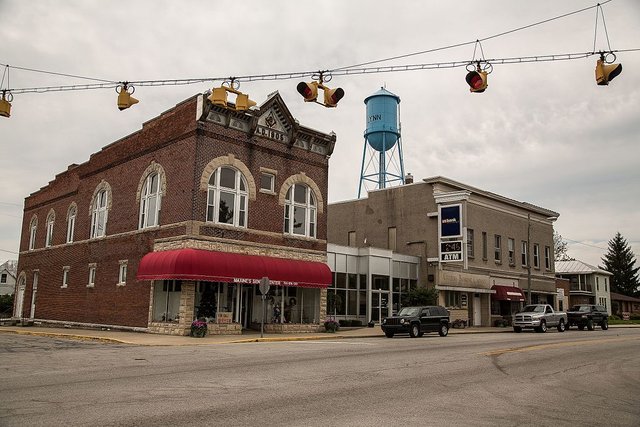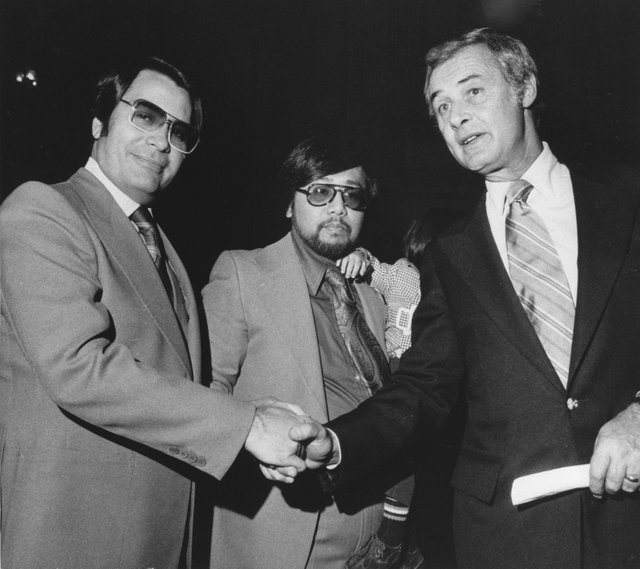Drinking the Kool-Aid: Part One, The Making of a Cult
The infamous Jonestown Massacre happened forty years ago. Jonestown was named after Jim Jones, the leader of a religious cult. Who was Jim Jones and how did he start a cult?
This is Part One of a short series of posts on the events leading up to The Jonestown Massacre on 18 November 1978. For the introduction please see Drinking the Kool-Aid: Introduction.

Lynne, Indiana
Who was Jim Jones?
James Warren Jones was born in the US state of Indiana on 13 May 1931. He was a true child of the Great Depression. Economic difficulties forced the Jones family to move to the small town of Lynne and live in a shack without plumbing. Talking about Lynne, he said:
Whenever I think about it, a great deal of pain comes. [I was] one of the poor in the community, never accepted, always on the wrong side of the tracks.
His mother was the breadwinner, working in a factory. She was a forceful woman and later became a union activist. His father was, according to Jones, a member of the Ku Klux Klan.
Jones is described as an intelligent and strange child. He was a voracious reader who studied Stalin, Marx, Mao, Gandhi, and Hitler, carefully noting the strengths and weaknesses of each. But he was instinctively drawn to religion. He joined the Pentecostal Church because, as he said, it was the most hated Church. He wanted to join a place where the most despised, the outcasts were accepted. He developed a great sensitivity to the problems faced by black people.
He greatly admired the preachers as they swayed the congregation. This was what he wanted to do.
Peoples Temple
Jones went to university in Indianapolis. Here he attended Communist Party gatherings. He became angered when the FBI started harassing his mother and frustrated at the ostracism of open communists, particularly the McCarthy Hearings. This provoked a seminal moment in which he asked himself, “How can I demonstrate my Marxism? The thought was, infiltrate the church.”
His open support of Communism didn't prevent him being recruited as a student pastor at a Methodist Church in Indianapolis. Jones claimed he left them because he was barred from integrating blacks into his congregation.
He then joined the Seventh Day Baptist Church after witnessing a faith healing service. He noticed how it attracted people and their money and thought with those financial resources, the Church would help accomplish his social goals. He organised a huge convention where he shared the pulpit with famous charismatic preachers.
With the success of the convention, Jones was able to launch his own church, which became known as the Peoples Temple Christian Church Full Gospel. The Church launched an inter-racial mission called The Peoples Temple.
In 1955 he formally launched the Peoples Temple. His message was less bible and more politics. He was a powerful preacher who could sway any crowd with his dramatic oratory. He was very outspoken about race and social justice. He promised his followers that he would lead them to “socialistic freedom” that would make the “desert bloom as a rose”. His church became an oasis in the desert of racial segregation.

Jim Jones and Rachel Dolezal image
In 1960 Jones was appointed the head of the Indianapolis Human Rights Commission. It was a highly controversial appointment and he was bitterly opposed by some sectors. He vigorously pursued racial integration of restaurants, theatres, hospitals, and so forth. Addressing a wildly cheering crowd at a meeting of the NAACP and Urban League, he yelled for his audience to be more militant, and then climaxed with, “Let my people go!”
:no_upscale()/cdn.vox-cdn.com/uploads/chorus_asset/file/4759565/peopletempleBEFORE.0.jpg)
The Peoples Temple, South Alvarado Street, Los Angeles image
Politics
Jones moved his church to California in 1965. His social programs blossomed. Peoples Temples became more than church buildings. There were day-care centres, soup kitchens and homeless shelters, drug rehabilitation centres, and old-age homes. Marginalised people were attracted by his personal concern for them and his ability to get them to believe in themselves.
His preaching drifted further and further away from Christianity. He preached of a coming nuclear holocaust after which a “surviving elect” would create a new socialist Eden on earth. By the early 1970s, he started deriding traditional Christianity and rejected the Bible as a tool to oppress women and blacks. The main theme in his Temple sermons was “Apostolic Socialism”. He started describing himself in messianic terms and claiming he was the reincarnation of figures like Christ and Buddha. He also claimed that his goal all along was communism, and, in a twist on the famous dictum that religion is the “opiate of the masses”, that religion was merely his way of making Marxism more palatable.
Within five years of moving to California, the Temple experienced a period of exponential growth and opened branches in cities including San Fernando, San Francisco, and Los Angeles. He moved the Temple's headquarters to San Francisco in 1971. The city was gripped radical protest movements at the time.
Jones soon became politically influential in San Francisco politics. He was able to bring large crowds to rallies and political demonstrations—Temple members bussed in from around California. Also, his social programs made him popular with left-wing politicians and he was able to gain public support through his contacts with politicians. He became close to influential San Fransisco politician George Moscone. In 1975, Jones was instrumental in getting Moscone elected as mayor of San Fransisco. Moscone subsequently appointed Jones as the chairman of the San Francisco Housing Authority Commission.

San Fransisco mayor George Moscone shakes hands with Jim Jones, 1977 image
Jones soon gained the support of politicians on the national stage. Among them were Walter Mondale, Rosalynn Carter, Jerry Brown and Harvey Milk—who spoke at Temple rallies. He forged close alliances with key columnists and others at the San Francisco Chronicle and other press outlets.
Jones was particularly close to Angela Davis, a radical left-wing activist. She had worked with the Communist Party and was involved in the Black Panther movement. Davis helped the Temple to forge close ties with the Nation of Islam, once his sworn enemy.
But all this influence and the huge growth of the Peoples Temple started drawing the attention of the investigative press.
This series on the Jonestown Massacre will be continued in Part Two, tomorrow
Previous post in this series:
Drinking the Kool-Aid: Introduction
References:
https://jonestown.sdsu.edu/?page_id=29478
https://www.theguardian.com/world/2018/nov/17/an-apocalyptic-cult-900-dead-remembering-the-jonestown-massacre-40-years-on
https://en.wikipedia.org/wiki/Jim_Jones
https://en.wikipedia.org/wiki/Peoples_Temple
https://en.wikipedia.org/wiki/Angela_Davis
Also posted on Weku, @tim-beck, 2018-11-20
He claimed to champion people who were marginalized, but had other motives.